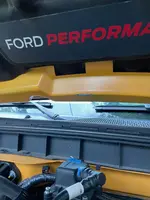Ok so I just watched a bit of the video and just a few thoughts. He's mistaken on compressor blow-by being the main source of carbon buildup. Companies (who aren't trying to sell you catch cans) have done extended tests and have seen no effective change in carbon buildup long term. I am the owner of a performance-oriented automotive company and many of the vehicles I cater to are DI motors. I could easily make catch can systems for any of them but it's disingenuous. I will occasionally whittle something up for a customer who insists.
Air/oil separators are there to reduce emissions, plain and simple. Back in the day, cranks and cylinder heads all vented to atmosphere. There are hp/efficiency gains to be had in creating negative crank case pressure.
What I usually recommend is more frequent oil changes (every 5K) and DO NOT let your car sit and warm up (remote start is really, really bad but yes, I still use it on occasion). Get in, start the car, drive as soon as you're able. This'll warm up the internals more quickly than idling and the piston rings will expand and start sealing sooner. This prevents volatiles (gas) from diluting your oil via blowby past piston rings that haven't fully expanded thermally creating a better seal between it and the cylinder wall. Those vapors get recycled via the PCV and don't collect in a catch can as its method of operation is condensation.
In order to consensate, there must be enough of a temp differential for it to occur (aka partially burned hot hydrocarbons hitting a "cool" intake valve). Those volatiles remained only partially burned as they're not processed to the extent that gas is and don't burn as efficiently. When both the intake and exhaust valves are open at the same time, however briefly, reversion occurs where the charge or burned gasses momentarily reverse flow due to pressure changes from positive to negative vacuum, forcing the gasses into the intake port. This is why positive pressure, created by the turbos, lessens carbon buildup as it's restricting reversion of combustion gasses.
Unfortunately the Braptor hasn't been out long for owners to experiment and I'm not aware of any long-term studies done on the 3.0L Ecoboost. I'd be open to reading any info though, just not from some guy projecting animation onto a wall. I will say it's a good overview of DI vs. port injection although it's pretty basic. There are big performance advantages to DI on both n/an and turbo motors. And many Toyotas use a throttle body injector, and not multi-port, to keep the valves clean. They've been doing it since the start of DI motors. No idea why Ford chose to forego a port or throttle body injector.
Understand that just because you're emptying a catch can that's full of oil, doesn't mean that oil is depositing on your intake valves and causing carbon buildup in the same ratio. Yes, a very, very small amount is in fact causing carbon buildup but if you were to install 20 catch cans, 10 on either bank, you'd still have carbon build up on the intake valves.
I know what you're thinking...what about the exhaust valves? After all, they're bathed in the exhaust gasses each combustion cycle. Well, they're almost as hot as the combustion chamber and thus, no condensation. Additionally, getting things hot, you can actually burn off the carbon. Take your DI motor out on the Autobahn and run it at top speed for two hours straight. Your intake valves will be as clean as a whistle!










